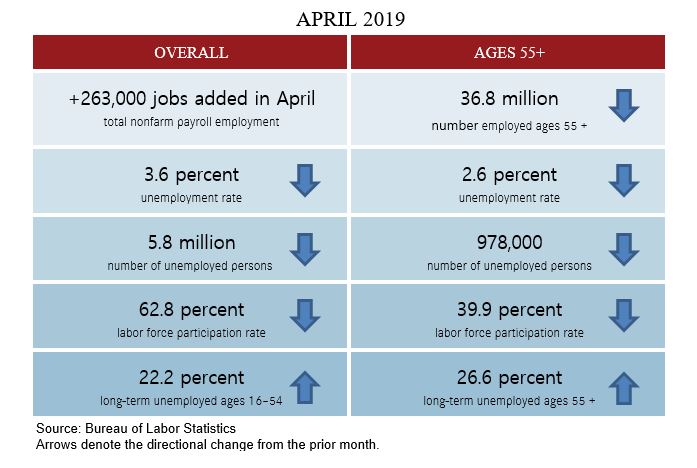AARP Eye Center
Unemployment Rate Down to 3.6 Percent in April
By Jennifer Schramm, May 3, 2019 04:34 PM

Employment Overview
Employment was up again in April, according to the Bureau of Labor Statistics (BLS) monthly Employment Situation data. The economy added 263,000 jobs, an increase from the 189,000 jobs added in March (revised down from +196,000 jobs). The unemployment rate declined to 3.6 percent for the workforce overall and was down to 2.6 percent for those ages 55 and older. The number of people ages 55+ who were unemployed dipped to under one million.
The overall labor force participation rate was down slightly from 63 percent to 62.8 percent. It also edged down for the 55+ from to 40.1 percent to 39.9 percent. Employment among the 55+ age group declined slightly to 36.8 million. While those ages 24 and younger continued to experience the shortest average durations of unemployment in April, those ages 35 to 44 and 45 to 54 showed slightly higher average durations of unemployment compared with those ages 55+.
Spotlight: Workers Ages 75 and Older
The BLS forecasts that workers ages 75 and older will have the fastest rate of growth in the labor force of any age group between 2016 and 2026. Among that age segment, women’s increases in labor force participation will significantly outpace their male counterparts, a 106.8 percent change in the labor force compared with 80.4 percent for men.
<strong>More Than Demographic Changes are Driving Older Workers’ Labor Force Participation</strong>
While the aging baby boom generation is a significant driver of these increases, the BLS bases its forecast on more than demographic changes. In addition to the use of population projections from the U.S. Census Bureau, the BLS also uses economic modeling to predict how industries will distribute jobs across occupations, all while taking into account trends in technology, changing skill requirements, and other factors. Therefore, the expected growth in the 75 and older workforce reflects more than the aging of the US population. It is also about how occupations, working conditions, skills and education, savings, and other economic drivers are all interacting to encourage longer years in the workforce for a growing number of people.
The Value of Older Workers to Businesses
While many older workers are staying on the job out of economic necessity, the AARP Longevity Economy Report observes that the workers who often remain longest in the workforce are those in occupations requiring the deepest levels of knowledge and experience. Analysis of BLS data shows that those with the highest levels of education are most likely to work beyond traditional retirement age. As more people enjoy healthier and longer lives, employers have an opportunity to leverage a profound source of knowledge, experience, and wisdom.
Find more details on the latest employment data in the April Employment Data Digest, PPI’s monthly review of job trends for those ages 55 and over. For more data to drive policy solutions, go to PPI's Data Explorer, and for information on skills, jobs, and occupations for the 50+, visit AARP's skills shortage data tool.

Jen Schramm is a senior strategic policy advisor at the AARP Public Policy Institute. Her areas of expertise include employment trends, policy challenges and opportunities related to workers and jobseekers ages 50 and above, and skills and credentialing for mid- and late-career workers.























































